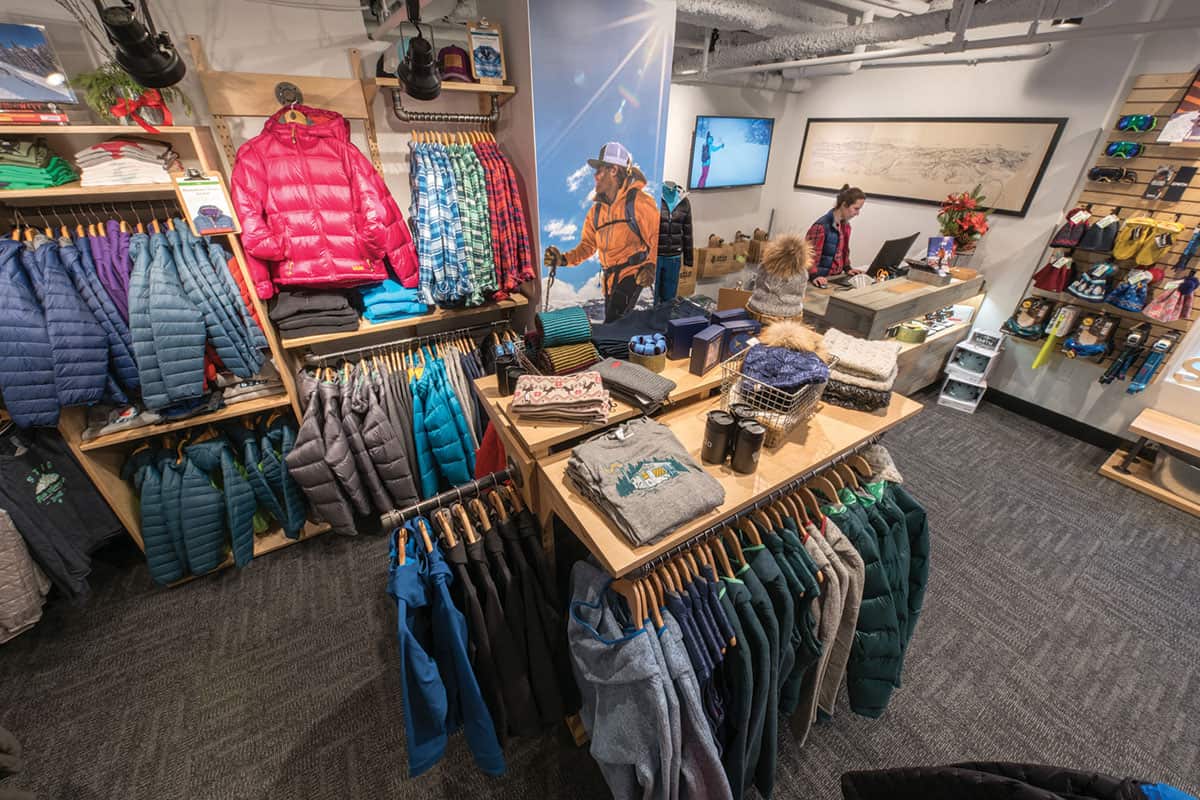Read The
Current Issue
Wearing Jackson Hole
Stio seeks to design outerwear inspired by the valley’s unique lifestyle. The result? Technical clothing that looks as good as it performs.
By john spina

WEDNESDAY, JANUARY 23, 2016, was a twenty-inch powder day that capped off an epic weeklong storm. That morning, employees of Stio, a Jackson-based outdoor apparel company, woke up to an email from their boss, Steve Sullivan. It was short and sweet: “If you’re not out skiing today I personally consider you lame.”
For Stio employees this email was nothing out of the ordinary. Sullivan—“Sulli”—built the company, which was founded in 2011 and remains headquartered here, around the concept of bottling or, rather, sewing up the valley’s lifestyle and sharing it with the world one piece of clothing at a time. “It’s an inherently authentic brand,” Sulli says. “From top to bottom, concept to finished product, the entire company is fueled by a desire to remain authentic to the Jackson Hole lifestyle—an existence epitomized by adventure, conservation, and, of course, fun.” Split between the wilderness and the workplace, the Jackson lifestyle requires clothing that is rugged, functional, and stylish. “We build apparel for the life we live here,” Sulli says. “Everybody in the office is an active end user of the product.”
STIO IS SULLI’S second venture in the world of outdoor apparel. His first was Cloudveil, which he founded in 1997 with friend Brian Cousins. That brand, named after a little-known peak to the south of the Grand Teton, was the first to successfully use modern-day soft-shell material in performance outerwear. (Cloudveil’s signature soft-shell piece, the Serendipity jacket, can still sometimes be spotted around the valley.) The company grew to sell to 600 retailers worldwide and had annual revenues of $25 million. While evolving into an international brand, Cloudveil took on investments from venture capitalists. In 2005, Sport Brands International (SBI) bought it; in 2008, Spyder bought it from SBI.
As the company got further and further away from its Jackson Hole roots, Sulli tried to buy it back, but eventually Apex Partners, which owned Spyder, sold it to Windsong Brands. That was the end of it for Sulli. “It was beyond sad,” he says. “I was incredibly upset; Cloudveil was a lifelong dream, but sometimes outside factors are beyond your control.” (Today, after several more owners, Cloudveil is Cloudveil Mountain Works and continues to produce outdoor gear. It hasn’t returned to the level of innovation and recognition that it had under Sulli and Cousins’ leadership, though.)
IT WAS A tough pill for Sulli to swallow, but the loss of Cloudveil gave shape to Stio. “[Cloudveil] was a million-dollar MBA,” Sulli says. One lesson: “I learned a lot about who I wanted to work with and who I didn’t.” Stio’s investors “do more than write a check. I get real value out of our team.” Best of all, Sulli says, “They’re not just financial partners—they’ve become friends and collaborators.”
Another example of a lesson learned is Stio’s direct-to-consumer business model. Though this model is considered somewhat risky—it eliminates the possibility of customers discovering Stio’s products on the racks at Teton Mountaineering or Skinny Skis or, farther afield, at an REI—it drastically shortens the feedback loop. This allows the company to more efficiently respond to the market and to take greater risks with designs.
For example: A typical product requires twelve to eighteen months to design and manufacture. After that, at Cloudveil, or any other company that sells through retailers, the product is then shared with reps and distributors, who spend several more months vetting it before presenting it to retailers. So if all goes well a product hits stores about six months after its production. And then it’s yet another six(ish) months to find out if consumers actually like it. “The reality of that cycle is that it was so lengthy, you could be developing styles or textiles only to find out the consumer didn’t like them,” Sulli says.
Stio has the same lead time to develop and produce a product—about twelve months—but then it goes to consumers in that thirteenth month. “We know if it’s a winner or a loser in forty-five days,” Sulli says.
Stio doesn’t just use the faster consumer feedback to help manage production and inventory, but also to beta test more creative, eclectic outerwear. “We’re not as afraid as, for example, a big wholesale company about releasing or testing new products,” Sulli says. “Because we’ve got great factory partnerships, we can build stuff in small runs for a test and see what happens. We put products out and then we listen to consumers speak.” Although sometimes consumer feedback is garbled.
People loved Stio’s Harkin snap shirt, a traditional men’s button-down with bold prints reminiscent of old, flannel ski shirts from the 1960s and ’70s. Seeing how popular the Harkin shirt was, Stio quickly got going on a reversible down jacket in the same line. As successful as the shirt was, though, the Harkin reversible down jacket was unloved. “It just didn’t resonate where the shirt did,” Sulli says. But Stio was able to quickly pivot from the jacket: “It’s out of the line now,” Sulli says. “We were quickly on to the next product, and we’re expanding on that shirt collection.”
Sulli says having the ability to promptly test the market is key, giving Stio the opportunity to push the boundaries of outdoor apparel and swing for the fences. If Stio strikes out every once in a while, it’s okay. “You know that Ted Williams quote about baseball being the only sport where you can be successful 30 percent of the time and be an All-Star?” Sulli asks. “It’s like that with Stio; it’s just more like 50 percent.”
CREATING THE RIGHT LOGO
All Stio products unobtrusively bear the image of a whitebark pine cone. Sometimes it’s printed; sometimes it’s embroidered. Whitebarks only grow in the West, in the harshest environments, and at the highest altitudes. Often gnarled and rarely taller than thirty feet, a whitebark’s beauty is one of function. Whitebarks eke out their existence at the uppermost reaches of the tree line; nothing about or on a whitebark is superfluous. “Like the whitebark pine, a lot of the design and aesthetic of our clothes is pretty simple,” says Brendan Levine, Stio’s senior graphic designer. “There are no bells and whistles you don’t need.”
While ruggedly unassuming, whitebark pines serve a critical function in the Greater Yellowstone Ecosystem. Its cones are a key source of food for animals, from squirrels to grizzly bears. “The whitebark pine plays a really important role in the Greater Yellowstone Ecosystem,” says Noah Waterhouse, Stio’s chief marketing officer. “Maybe [Stio] is not a huge part in the Jackson ecosystem, but we’re a cog.”

STIO MOUNTAIN STUDIO
While Stio doesn’t sell to retailers, it opened the first Stio Mountain Studio in 2012, just off Jackson’s Town Square. It opened a second studio in Teton Village and is looking to open additional shops in towns like Boulder, Colorado; Bozeman, Montana; Park City, Utah; and Lake Tahoe, California. Sulli and his team have also played with the idea of setting up shop in a major metropolitan area like Chicago or New York. “Brick and mortar is a big part of our long-term growth strategy,” Sulli says.




